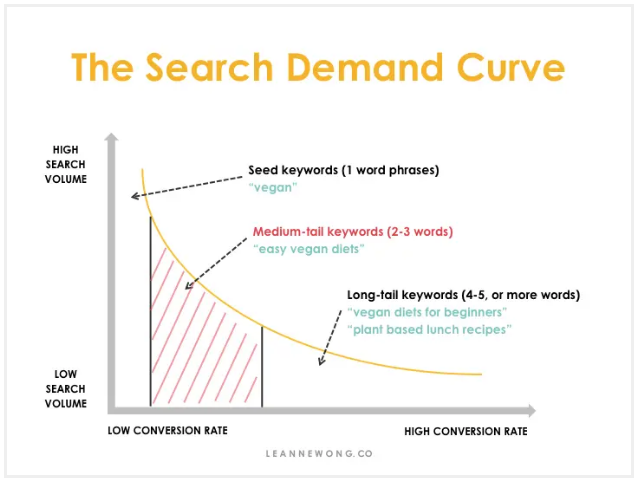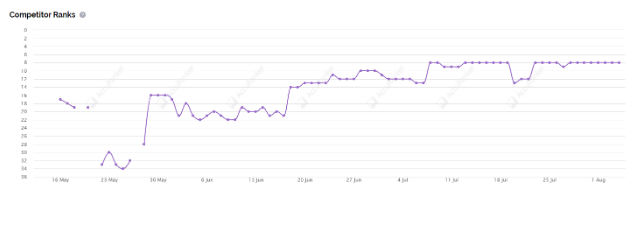How to Improve SEO on Google: A Case Study with Proof
If you are searching for ways to improve your search engine optimization on Google, you’ve come to the right place.
In this article, I explain how I increased my search traffic for one of my blog posts in just six months by using specific SEO tactics.
I’ll provide you with real social proof from my site, OneHourProfessor.com, to show how I optimize different aspects of the article for the best results.
Without further ado, let’s jump right in.
1. Use Keyword Research Tools
One of the most effective SEO optimization tactics is to use keyword research tools to help you choose the best keyword for a particular piece of content.
A good target keyword is one that has a high enough keyword search volume to generate at least a few hundred blog visitors each month.
The keyword difficulty (KD) should be low enough that you are able to compete for it.
So, while you may not be able to rank for a seed keyword like “vegan”, you may have an easier time ranking for a medium-tail phrase like “easy vegan diets”.
Better yet, a long-tail keyword like “vegan diets for beginners” will be easier still for you to rank for.
The graph below shows the search demand curve for these different types of keywords:

I select a single long-tail keyword and strategically place it in different areas of the post, such as:
- The title
- Headings
- Introduction
- Body
- Conclusion
- CRO tables and other elements
- Alt-text in images
- Image captions
… and elsewhere throughout a piece of content.
The trick here is to optimize without over-optimizing.
The most important thing is to ensure your keyword is in the title and first paragraph of your blog post. This is an absolute must, and there are a few factors to keep in mind to ensure that you optimize your title for SEO.
For instance, make sure your target keyword is at, or near the beginning of your title. Keep the title under 70 characters long, and add power words and numbers to make your title more enticing so you can get more clicks.
Another important element to optimize is the first paragraph. Make sure you include your exact match keyword within the first few lines of your post. For example, if you want to rank for “best video editor”, then you need to include that exact phrase within your introduction paragraph text.
You can also optimize your paragraph with related keywords to help build a semantic relationship around the main topic. This will improve the contextual relevance of your post.
My Example:

In my case, I was able to see that the keyword “privacy policy generators” had competition, but didn’t seem out of reach due to my website having a domain rating (a measure of how authoritative your site is by Ahrefs.com) of 76. Once I discovered the opportunity, I created this post that details some of the best privacy policy generators on the market, as well as what people should look for when they decide to purchase one.
It’s worth noting that this tactic has worked on many posts of mine in highly competitive niches such as webinar software, podcast hosting, and online course platforms.
Pro Tip: Use Google’s Predictive Search to Discover Popular Keywords
You can use the “predictive search” feature on Google to help you find popular keywords. This is an extremely underutilized part of search engine optimization that will get you better keyword research results.
One of the best reasons why this feature is so effective is because the suggestions come from Google itself. This goldmine is an aggregate of all the platform’s most popular keyword searches based on any seed keywords you choose, as shown in the example below:

2. Build Backlinks
You also need to build backlinks to increase authority on the site and page so you can rank higher and drive more targeted traffic to your site.
Some blogs do very little in the way of backlink building, but I have found this to be one of the best ways to rank content quickly.
I have two strategies for this: linking to current assets and writing guest posts.
Link to Current Assets: First, I link new content to assets that I already own, such as other articles on different sites, online courses, etc. This is a great strategy to use if you already have other websites you own in related niches.
Write Guest Posts: My second strategy for backlinking is to write guest posts on authority websites in my niche. This works particularly well for generating high-quality backlinks, but the method does require consistent effort before it starts to pay off.
Broken Links: You may also consider doing a bit of broken link building. Although this isn’t part of my SEO strategy, I do believe that any active link-building you can do will net you positive results in your search optimization efforts.
My Example:

In my case, I felt that the best way to build backlinks for the Privacy Policy post I mentioned earlier was to write guest posts and have various outlets pointing to this page. This ended up leading to roughly 6-8 dofollow links from highly authoritative domains, which then led to more links pointing to the page that occurred naturally. At present, I have 32 referring domains to the page and likely more on the way.
3. Use a Natural Language Processing (NLP) SEO Tools
Another effective way to grow your business organically is to use SEO tools that are based on natural language processing.
Google and other search engines are continually working to make search more natural and relevant.
One of the ways they do this is through the use of conversational language and natural language processing (NLP).
NLP is a change in Google’s algorithm with a huge impact on SEO. It focuses on better understanding the context of user searches (not just the keywords) in order to improve search quality.
The importance of using a natural language processing SEO tool can not be overstated if your goal is to kickstart or maintain your page rankings.
Such a tool will help you determine what other secondary keywords should be included for optimal search engine rankings on Google, and that’s why you should start using it as soon as possible.
For instance, you can target medium-tail keywords with 2 to 3 words, significant search volume, and medium conversion potential.
“Significant search volume” means that the keyword phrases have 1k-10k in monthly searches, and “medium conversion potential” means the particular keyword has specific intent – particularly intent for taking action, such as “easy vegan recipes” or “cheap website builders”, etc.
Examples of NLP-based SEO tools include:
Surfer SEO
SurferSEO is a great tool that helps you quickly and easily plan/manage/update your content so that it includes a variety of NLP recommendations. While there are many tools on the market, I personally feel that this is the most useful/successful at helping content creators optimize.
Google NLP
Google’s NLP has an interface that allows users to paste a piece of text and get an insightful analysis using both machine learning and natural language. It helps you extract insights from the text, and if the text is up to par, then the content gets a high salience rating; otherwise, the system reviews your writing according to many factors, including SEO keywords to help you create effective content for Google
SEOScout
SEOScout is a content-optimization tool that leverages NLP to discover the right keywords for your website.
The platform gives you the ability to “spy” on competitor businesses in order to find their top keywords so you can dig into their search results using the topic research tools.
The NLP feature analyses the top 30 results for specific keywords and scores them based on their popularity for websites to plan comprehensive content.
Furthermore, this keyword rank tracker also comes with an SEO editor that helps you find and leverage gaps in the content for better readability and depth.
Pro Tip: Use NLP + Links Effectively
As you do your SEO for your website, NLP is a factor that you must account for if you are going to be successful in generating better SEO results. Make sure you use it in conjunction with internal and external backlinks in order to get the best results.
There’s a new dimension to links, and they are no longer just about authority and relevance, but also about context.
Because of NLP, link structure and placement have become crucial factors. Now, anchor text is important, as well as whether or not it’s contextually relevant to the page. Moreover, you also need to pay attention to where it’s placed on the page.
Only place a link on a page if it makes sense to the content. In other words, ensure the link has the right context for it to have full value.
My Example:

Usually I like to publish a post without focusing on NLP data at all, and instead write it however I think it should be written. From there, after building some links and seeing traction, I’ll go back into the post and optimize using an NLP tool. For me, the tool of choice here is SurferSEO as I’ve had success with it, though other tools like it exist.
As you can see in the screenshot above, I did this with my privacy policy post and was able to get the score in the low 90’s, which is generally where I want to be.
I also want to mention that I like to use SEO Booster if I’m trying to optimize content on Shopify. While SurferSEO is great for WordPress website, I think SEO Booster is a hidden gem in the Shopify space. It doesn’t focus as much on NLP data, but it can really help optimize Shopify stores/sites and I’ve had great success with it personally, so it’s worth mentioning.
4. Use Search Tracking Tools
One of the first things you need to do to optimize your articles for Google is to use search ranker tools to track how well each article is ranking for specific keywords.
With the right tools, you’ll be able to track ranking positions for any domain in Google and other search engines.
This can be for global or local ranking, and you’ll get actionable insights on ways to improve search ranking for any of your online content.
Here are some examples of Search Ranker Tools:
AccuRanker
AccuRanker is a dedicated keyword position checker with an intuitive interface that makes it easy for anyone to get started, even if they are not an SEO pro. The tool allows you to track keyword ranking for any piece of content in Google search. There’s also an option for Bing and Yandex keyword monitoring.
You get blazingly fast and accurate results, and with a single click, you’ll be able to see a preview of the search results – a feature that is perfect for agencies that want to show ranking proof to clients.
Another cool feature of this platform is that it allows you to check ranking according to your target city or country. Whenever you add a new keyword to track, you have the ability to set the target location(s).
Plans differ according to the number of keywords you need to track and there’s a free 14-day trial to test out the software before committing to a premium plan.
SEMRush
SEMRush is a complete solution for keyword checking. Simply enter your website URL or individual URLs for blog posts and the tool will show you the keywords that you’re currently ranking for.
Click any of the keywords displayed in the results to check details, such as keyword competition and more.
You can choose Google or Bing search according to your target geographical region so you have a clear snapshot of all the keywords you rank for. This is a professional keyword tracking software that is extremely easy to use and comes with a free two-week trial.
Pro Tip: Exercise Patience.
One of the main reasons people fail to get traffic with SEO is that they give up too early and miss out on seeing phenomenal results from their efforts.
During the first few months after implementing your SEO strategy, you may not see the results you hope for, but keep in mind that SEO is a long-term game, and if you persevere, you will experience long-term value.
An article may cost you a couple of hundred dollars to create, but once its ranks, it will bring in traffic every single day – potentially for years.
My Example:

It always amazes me how many people will publish a post and then ignore it. This is the wrong way to win on Google. Not only should you publish content, but you also need to go back and review how it performs over time and adjust it at regular intervals, especially if you’re in a competitive niche. To keep track of things, I personally like to use Accuranker as it has a lot of interesting insights and tracks the keyword positions over time.
As you can see in the graph below, I’ve presently been stuck at position #8 for a month or so, but I intend on slightly revising content soon to increase this position even further.
Conclusion
I hope this case study has helped you learn how to improve your Google SEO effectively.
Ranking your content on Google’s first page will transform your business, and this is a real example of where I applied search engine optimization methods to achieve success.
You now have the information you need to emulate successful SEO for Google.
Just remember, the most important thing is to make your website interesting and useful. These tactics alone won’t bring you success unless you know what your readers want and give it to them in a way that cultivates user trust and positions you as an authority on the subject.
Are you ready to start using these tips to help you grow your own blog by ranking your content in the top spots? Share your thoughts below!
***
 Ron Stefanski is a website entrepreneur and marketing professor who has a passion for helping people create and market their own online business. You can learn more from him by visiting OneHourProfessor.com
Ron Stefanski is a website entrepreneur and marketing professor who has a passion for helping people create and market their own online business. You can learn more from him by visiting OneHourProfessor.com














